Introduction to Astronomy
White Dwarfs:
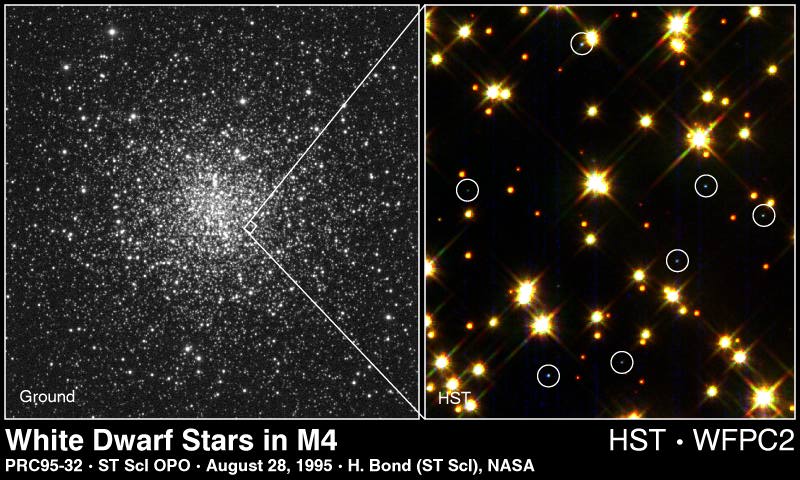 White dwarfs are hot (10,000K), dim stars. This at first seems like a
contradiction all by itself, since hot things are usually quite bright.
However, white dwarfs are also very small...
White dwarfs are hot (10,000K), dim stars. This at first seems like a
contradiction all by itself, since hot things are usually quite bright.
However, white dwarfs are also very small...
They are made mainly of electron-degenerate matter, which means
that the pressure does not respond to an increase in temperature in the
usual way. This causes white dwarfs to have the odd property that if
their mass increases their radius decreases. Stop and think about that
for a second. Most things in regular life don't operate that way. If a
dog is larger, it has more mass, as a rule. Bigger slugs are more
massive than smaller slugs. For example:
- a 0.5 MSun white dwarf has a radius of 1.5 REarth
- a 1.0 MSun white dwarf has a radius of 0.9 REarth
- a 1.3MSun white dwarf has a radius of 0.4 REarth
This is pretty weird.
The largest possible white dwarf mass is 1.4 MSun.
This is called the Chandresekhar limit, and is the most mass that the
electron degenerate core can hold up. Objects with larger masses either
lose the mass while still on the Asymptotic Giant Branch, or contract
still further to become neutron stars or black holes.
Once a white dwarf has collapsed to its final size, it has no
more nuclear fuels. The interior, which still has heat from before,
radiates that heat away slowly over time. This is similar to what
happens to a big lump of steel when you take it out of the smelter. It
gradually cools down, fading from white hot to blue hot to yellow to
red, and eventually becomes a cold, steel-colored lump. The star, just
like the steel, remains the same size the whole time.
As the star cools, its luminosity decreases, just as you'd
expect. This process slows over time, so that the dimmer it gets, the
slower it gets dimmer...
A 0.6 MSun star will:
- drop to a luminosity of 0.1 LSun in 20 million yrs.
- drop to a luminosity of 0.01 LSun in 300 million yrs.
- drop to a luminosity of 0.001 LSun in 1 billion yrs.
- drop to a luminosity of 0.0001 LSun in 6 billion yrs.
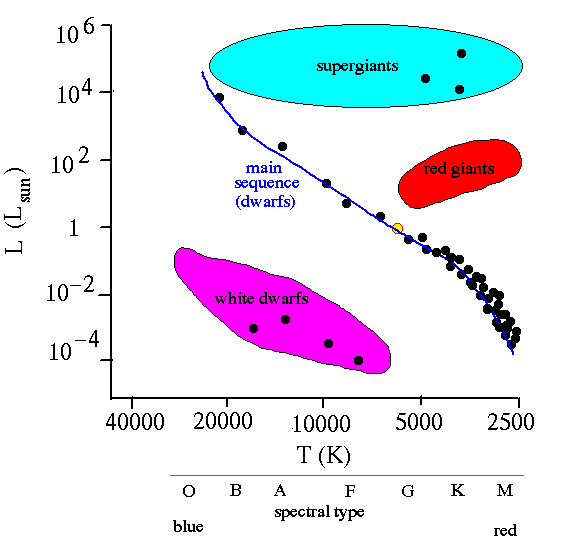 At
this point, the temperature (and therefore the color---why?) of the
star are about the same as the Sun's, but the luminosity is much less,
because it is so small. White dwarfs are found at the bottom of the
HR-diagram, with their temperature depending on how much cooling they
have done.
Where do these objects come from?
They are the central stars of planetary nebulae, and their final mass depends on their initial main sequence mass:
At
this point, the temperature (and therefore the color---why?) of the
star are about the same as the Sun's, but the luminosity is much less,
because it is so small. White dwarfs are found at the bottom of the
HR-diagram, with their temperature depending on how much cooling they
have done.
Where do these objects come from?
They are the central stars of planetary nebulae, and their final mass depends on their initial main sequence mass:
- a 2-8 MSun main sequence star produces a 0.7-1.4 MSun white dwarf.
- a < 2 MSun main sequence star produces a 0.6-0.7 MSun white dwarf.
- a < 1 MSun main sequence star produces a < 0.6 MSun white dwarf.
No white dwarfs with masses less than 0.6 MSun yet exist. The Universe is not yet old enough for stars of less than 1 MSun to have evolved to the white dwarf stage.
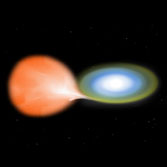 Single white dwarfs can do nothing at this point except continue to
cool until they are dark, cold clumps of mass, just sitting there in
the galaxy. Some people call this endpoint a 'black dwarf'. They are
the logical consequence of a single white dwarf cooling down. (A white
dwarf that is part of a binary system, however, can produce a Type I
supernovae, which is somewhat more exciting than just cooling down
forever and ever. See picture at right.)
Single white dwarfs can do nothing at this point except continue to
cool until they are dark, cold clumps of mass, just sitting there in
the galaxy. Some people call this endpoint a 'black dwarf'. They are
the logical consequence of a single white dwarf cooling down. (A white
dwarf that is part of a binary system, however, can produce a Type I
supernovae, which is somewhat more exciting than just cooling down
forever and ever. See picture at right.)
Neutron Stars
Neutron stars are produced by main sequence stars of 8-25 MSun.
These stars become supernovae, lose a lot of their envelope, and leave
a degenerate neutron core behind. We are once again talking about
degenerate matter, and so the star gets smaller when it is more
massive.
For a sense of scale: a 1.7 MSun neutron star has a radius of ~10 km! That's smaller than Seattle!
The maximum mass of a neutron star is probably a bit less than 2.7 MSun, but our understanding of the gravitational physics involved in these weird objects is not quite good enough to be certain.
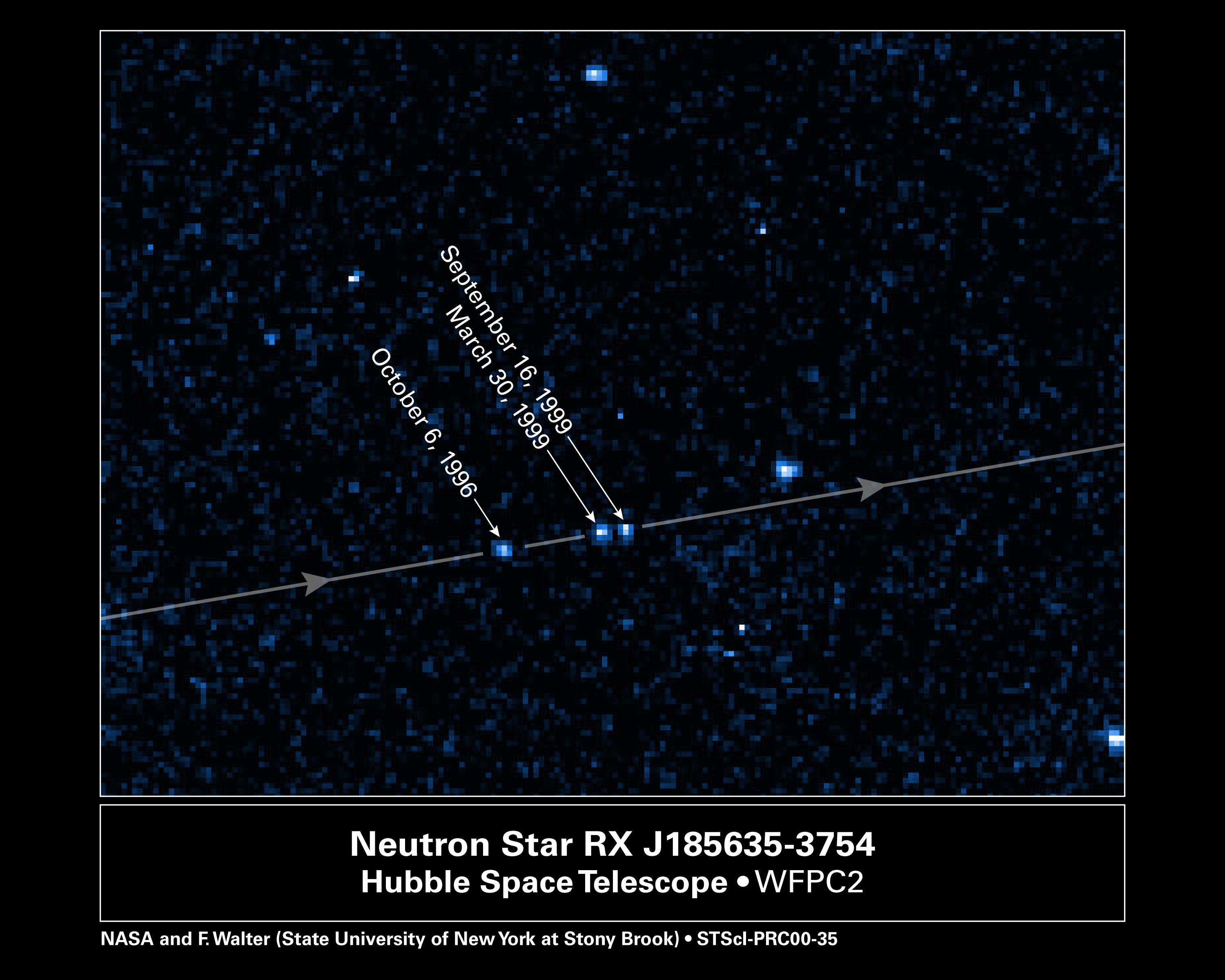 The
Motion of RX J185635-3754 - The Nearest Neutron Star to Earth, was
captured by Hubble Space Telescope from 1996 to 1999. This neutron star
is 200 light years from the Earth.
These neutron stars collapsed from larger stars, and during
that collapse, angular momentum must have been conserved. That means
the stars are rotating very
rapidly, about 1000 times per second! They also have large magnetic
fields, due to the collapse and compression of the original magnetic
field of the star.
The
Motion of RX J185635-3754 - The Nearest Neutron Star to Earth, was
captured by Hubble Space Telescope from 1996 to 1999. This neutron star
is 200 light years from the Earth.
These neutron stars collapsed from larger stars, and during
that collapse, angular momentum must have been conserved. That means
the stars are rotating very
rapidly, about 1000 times per second! They also have large magnetic
fields, due to the collapse and compression of the original magnetic
field of the star.
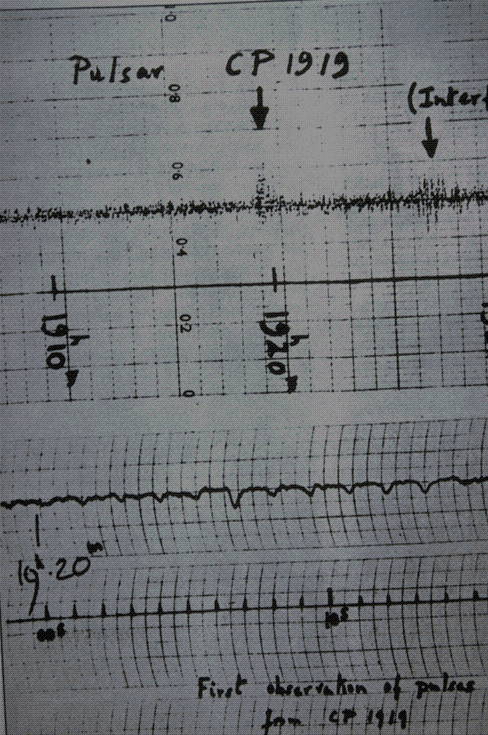 One special type of neutron star is the pulsar.
In 1967, at Cambridge University, a graduate student named Jocelyn Bell
was working for this guy named Hewish, setting up 2048 radio antennas
all over the English country-side. Once she had this large radio
telescope working, she started collecting data, which in those days was
recorded on a chart recorder. (Chart recorders spew out reams of paper,
kind of like one of those old-fashioned ticker-tape machines. Along the
paper is the time axis, and across the paper is the strength of the
radio signal.) She noticed, if you can believe this, that every 400 feet
(pace this off for yourself sometime...), there was a little fuzzy blip
in the signal on her paper. Hewish thought she was mad. But she was
persistent, figured out that it came from the sky (how would you do
this?), and finally gathered enough data that he started to take it
seriously. Their first thought was "little green men", which made Bell
pretty mad, because it would get in the way of her finishing her thesis
so she could stop working for Hewish. But then, they found another one,
and another one, and it seemed pretty unlikely that little green men
would be trying to communicate from all these different places in
exactly the same way, at exactly the same time. So another guy came up
with the idea of a spinning neutron star. (By the way, Hewish got the
Nobel Prize for the discovery, and didn't share it with Bell. Or with
the guy who figured out it was a neutron star.) What Bell had
discovered was a pulsar.
One special type of neutron star is the pulsar.
In 1967, at Cambridge University, a graduate student named Jocelyn Bell
was working for this guy named Hewish, setting up 2048 radio antennas
all over the English country-side. Once she had this large radio
telescope working, she started collecting data, which in those days was
recorded on a chart recorder. (Chart recorders spew out reams of paper,
kind of like one of those old-fashioned ticker-tape machines. Along the
paper is the time axis, and across the paper is the strength of the
radio signal.) She noticed, if you can believe this, that every 400 feet
(pace this off for yourself sometime...), there was a little fuzzy blip
in the signal on her paper. Hewish thought she was mad. But she was
persistent, figured out that it came from the sky (how would you do
this?), and finally gathered enough data that he started to take it
seriously. Their first thought was "little green men", which made Bell
pretty mad, because it would get in the way of her finishing her thesis
so she could stop working for Hewish. But then, they found another one,
and another one, and it seemed pretty unlikely that little green men
would be trying to communicate from all these different places in
exactly the same way, at exactly the same time. So another guy came up
with the idea of a spinning neutron star. (By the way, Hewish got the
Nobel Prize for the discovery, and didn't share it with Bell. Or with
the guy who figured out it was a neutron star.) What Bell had
discovered was a pulsar.
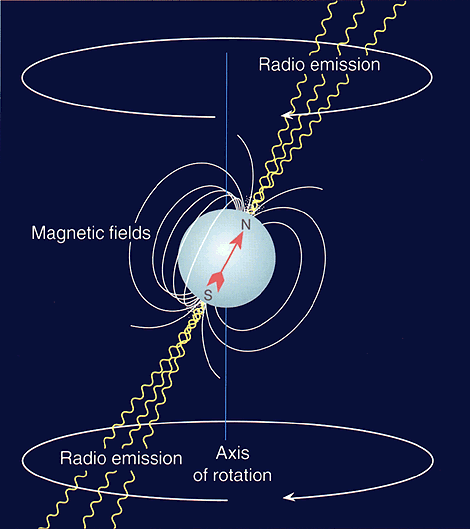 Pulsars are spinning neutron stars, with the magnetic field axis not
aligned with the rotation axis (this happens with lots of things, our
own Earth is one example). Along the magnetic field lines that come out
of the pole are many spiraling charged particles, which emit radiation.
When one of these poles is pointed towards us, we see a flash of light.
When neither is pointed towards us, we don't see any light. The whole
system functions very much like a light house.
There can be variations in these pulses. Sometimes individual pulses
are shaped differently, and sometimes there are quiet periods with no
pulses at all. This implies that the charged particles come out of the
star slowly over time.
A movie
of the variations of the nebula surrounding the pulsar at the center of
the crab nebula has been created using both X-ray (left) and optical
(right) images.
The spinning of the pulsar slows down over time. It takes about
30 million years for the rotation to slow from 0.001 seconds to 2
seconds. This is pretty short compared to the age of the Universe, so
you might expect to see lots of these with periods longer than 2
seconds. However, no pulsar has ever been observed with a period longer
than 5 seconds. This implies that there must be some sort of shut-off
mechanism for the charged particles as the star slows its spinning.
It is possible to make a map of our location in the galaxy
using pulsars. Cataloging where we see pulsars with particular periods
will identify not only a unique location, but also a unique time. This
has been done, and was sent on the record that went out with Voyager.
If any aliens find it (and can figure out what the heck we wrote), they
will know exactly when and where the spacecraft originated!
Pulsars are spinning neutron stars, with the magnetic field axis not
aligned with the rotation axis (this happens with lots of things, our
own Earth is one example). Along the magnetic field lines that come out
of the pole are many spiraling charged particles, which emit radiation.
When one of these poles is pointed towards us, we see a flash of light.
When neither is pointed towards us, we don't see any light. The whole
system functions very much like a light house.
There can be variations in these pulses. Sometimes individual pulses
are shaped differently, and sometimes there are quiet periods with no
pulses at all. This implies that the charged particles come out of the
star slowly over time.
A movie
of the variations of the nebula surrounding the pulsar at the center of
the crab nebula has been created using both X-ray (left) and optical
(right) images.
The spinning of the pulsar slows down over time. It takes about
30 million years for the rotation to slow from 0.001 seconds to 2
seconds. This is pretty short compared to the age of the Universe, so
you might expect to see lots of these with periods longer than 2
seconds. However, no pulsar has ever been observed with a period longer
than 5 seconds. This implies that there must be some sort of shut-off
mechanism for the charged particles as the star slows its spinning.
It is possible to make a map of our location in the galaxy
using pulsars. Cataloging where we see pulsars with particular periods
will identify not only a unique location, but also a unique time. This
has been done, and was sent on the record that went out with Voyager.
If any aliens find it (and can figure out what the heck we wrote), they
will know exactly when and where the spacecraft originated!












 White dwarfs are hot (10,000K), dim stars. This at first seems like a
contradiction all by itself, since hot things are usually quite bright.
However, white dwarfs are also very small...
White dwarfs are hot (10,000K), dim stars. This at first seems like a
contradiction all by itself, since hot things are usually quite bright.
However, white dwarfs are also very small...
 At
this point, the temperature (and therefore the color---why?) of the
star are about the same as the Sun's, but the luminosity is much less,
because it is so small. White dwarfs are found at the bottom of the
HR-diagram, with their temperature depending on how much cooling they
have done.
Where do these objects come from?
They are the central stars of planetary nebulae, and their final mass depends on their initial main sequence mass:
At
this point, the temperature (and therefore the color---why?) of the
star are about the same as the Sun's, but the luminosity is much less,
because it is so small. White dwarfs are found at the bottom of the
HR-diagram, with their temperature depending on how much cooling they
have done.
Where do these objects come from?
They are the central stars of planetary nebulae, and their final mass depends on their initial main sequence mass:
 Single white dwarfs can do nothing at this point except continue to
cool until they are dark, cold clumps of mass, just sitting there in
the galaxy. Some people call this endpoint a 'black dwarf'. They are
the logical consequence of a single white dwarf cooling down. (A white
dwarf that is part of a binary system, however, can produce a Type I
supernovae, which is somewhat more exciting than just cooling down
forever and ever. See picture at right.)
Single white dwarfs can do nothing at this point except continue to
cool until they are dark, cold clumps of mass, just sitting there in
the galaxy. Some people call this endpoint a 'black dwarf'. They are
the logical consequence of a single white dwarf cooling down. (A white
dwarf that is part of a binary system, however, can produce a Type I
supernovae, which is somewhat more exciting than just cooling down
forever and ever. See picture at right.)
 The
Motion of RX J185635-3754 - The Nearest Neutron Star to Earth, was
captured by Hubble Space Telescope from 1996 to 1999. This neutron star
is 200 light years from the Earth.
These neutron stars collapsed from larger stars, and during
that collapse, angular momentum must have been conserved. That means
the stars are rotating very
rapidly, about 1000 times per second! They also have large magnetic
fields, due to the collapse and compression of the original magnetic
field of the star.
The
Motion of RX J185635-3754 - The Nearest Neutron Star to Earth, was
captured by Hubble Space Telescope from 1996 to 1999. This neutron star
is 200 light years from the Earth.
These neutron stars collapsed from larger stars, and during
that collapse, angular momentum must have been conserved. That means
the stars are rotating very
rapidly, about 1000 times per second! They also have large magnetic
fields, due to the collapse and compression of the original magnetic
field of the star.
 One special type of neutron star is the pulsar.
In 1967, at Cambridge University, a graduate student named Jocelyn Bell
was working for this guy named Hewish, setting up 2048 radio antennas
all over the English country-side. Once she had this large radio
telescope working, she started collecting data, which in those days was
recorded on a chart recorder. (Chart recorders spew out reams of paper,
kind of like one of those old-fashioned ticker-tape machines. Along the
paper is the time axis, and across the paper is the strength of the
radio signal.) She noticed, if you can believe this, that every 400 feet
(pace this off for yourself sometime...), there was a little fuzzy blip
in the signal on her paper. Hewish thought she was mad. But she was
persistent, figured out that it came from the sky (how would you do
this?), and finally gathered enough data that he started to take it
seriously. Their first thought was "little green men", which made Bell
pretty mad, because it would get in the way of her finishing her thesis
so she could stop working for Hewish. But then, they found another one,
and another one, and it seemed pretty unlikely that little green men
would be trying to communicate from all these different places in
exactly the same way, at exactly the same time. So another guy came up
with the idea of a spinning neutron star. (By the way, Hewish got the
Nobel Prize for the discovery, and didn't share it with Bell. Or with
the guy who figured out it was a neutron star.) What Bell had
discovered was a pulsar.
One special type of neutron star is the pulsar.
In 1967, at Cambridge University, a graduate student named Jocelyn Bell
was working for this guy named Hewish, setting up 2048 radio antennas
all over the English country-side. Once she had this large radio
telescope working, she started collecting data, which in those days was
recorded on a chart recorder. (Chart recorders spew out reams of paper,
kind of like one of those old-fashioned ticker-tape machines. Along the
paper is the time axis, and across the paper is the strength of the
radio signal.) She noticed, if you can believe this, that every 400 feet
(pace this off for yourself sometime...), there was a little fuzzy blip
in the signal on her paper. Hewish thought she was mad. But she was
persistent, figured out that it came from the sky (how would you do
this?), and finally gathered enough data that he started to take it
seriously. Their first thought was "little green men", which made Bell
pretty mad, because it would get in the way of her finishing her thesis
so she could stop working for Hewish. But then, they found another one,
and another one, and it seemed pretty unlikely that little green men
would be trying to communicate from all these different places in
exactly the same way, at exactly the same time. So another guy came up
with the idea of a spinning neutron star. (By the way, Hewish got the
Nobel Prize for the discovery, and didn't share it with Bell. Or with
the guy who figured out it was a neutron star.) What Bell had
discovered was a pulsar.
 Pulsars are spinning neutron stars, with the magnetic field axis not
aligned with the rotation axis (this happens with lots of things, our
own Earth is one example). Along the magnetic field lines that come out
of the pole are many spiraling charged particles, which emit radiation.
When one of these poles is pointed towards us, we see a flash of light.
When neither is pointed towards us, we don't see any light. The whole
system functions very much like a light house.
There can be variations in these pulses. Sometimes individual pulses
are shaped differently, and sometimes there are quiet periods with no
pulses at all. This implies that the charged particles come out of the
star slowly over time.
A movie
of the variations of the nebula surrounding the pulsar at the center of
the crab nebula has been created using both X-ray (left) and optical
(right) images.
The spinning of the pulsar slows down over time. It takes about
30 million years for the rotation to slow from 0.001 seconds to 2
seconds. This is pretty short compared to the age of the Universe, so
you might expect to see lots of these with periods longer than 2
seconds. However, no pulsar has ever been observed with a period longer
than 5 seconds. This implies that there must be some sort of shut-off
mechanism for the charged particles as the star slows its spinning.
It is possible to make a map of our location in the galaxy
using pulsars. Cataloging where we see pulsars with particular periods
will identify not only a unique location, but also a unique time. This
has been done, and was sent on the record that went out with Voyager.
If any aliens find it (and can figure out what the heck we wrote), they
will know exactly when and where the spacecraft originated!
Pulsars are spinning neutron stars, with the magnetic field axis not
aligned with the rotation axis (this happens with lots of things, our
own Earth is one example). Along the magnetic field lines that come out
of the pole are many spiraling charged particles, which emit radiation.
When one of these poles is pointed towards us, we see a flash of light.
When neither is pointed towards us, we don't see any light. The whole
system functions very much like a light house.
There can be variations in these pulses. Sometimes individual pulses
are shaped differently, and sometimes there are quiet periods with no
pulses at all. This implies that the charged particles come out of the
star slowly over time.
A movie
of the variations of the nebula surrounding the pulsar at the center of
the crab nebula has been created using both X-ray (left) and optical
(right) images.
The spinning of the pulsar slows down over time. It takes about
30 million years for the rotation to slow from 0.001 seconds to 2
seconds. This is pretty short compared to the age of the Universe, so
you might expect to see lots of these with periods longer than 2
seconds. However, no pulsar has ever been observed with a period longer
than 5 seconds. This implies that there must be some sort of shut-off
mechanism for the charged particles as the star slows its spinning.
It is possible to make a map of our location in the galaxy
using pulsars. Cataloging where we see pulsars with particular periods
will identify not only a unique location, but also a unique time. This
has been done, and was sent on the record that went out with Voyager.
If any aliens find it (and can figure out what the heck we wrote), they
will know exactly when and where the spacecraft originated!